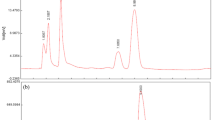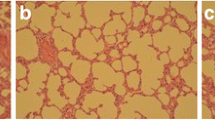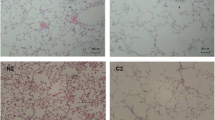Abstract
Background
Chronic obstructive pulmonary disease (COPD) is a epidemic disease which is mainly due to cigarette smoking. The effect of carvacrol on systemic inflammation in guinea pig model of COPD was examined in the present study.
Methods
Guinea pigs of both sexes were divided into 6 groups, including: control, COPD, COPD + drinking water containing three concentrations of carvacrol and COPD + dexamethasone. Animals were exposed to cigarette smoke for 3 months in order to induce animal model of COPD. Weight changes, serum levels of IL-8 and malondialdehyde (MDA) as well as total and differential white blood cell (WBC) were measured (n = 5 for control and COPD groups and n = 6 for other groups).
Results
Serum levels of IL-8 and MDA, total WBC (p < 0.01 for all cases) and eosinophil counts (p < 0.05) were increased and weight changes were decreased (p < 0.05) in COPD group compared to controls. Serum MDA level and total WBC in treated groups with two higher carvacrol concentrations, eosinophil, neutrophil and lymphocyte percentage in those treated with its high concentration as well as IL-8 level and weight change in treated groups with its all concentrations and in dexamethasone treated group were significantly improved compared to COPD group (p < 0.05 to p < 0.001).
Conclusion
These results showed a preventive effect of the carvacrol on all measured parameter in COPD guinea pigs which was comparable to the effect of dexamethasone at used concentrations.
Similar content being viewed by others
Abbreviations
- COPD:
-
chronic obstructive pulmonary disease
- MDA:
-
malondialdehyde
- WBC:
-
white blood cell
References
Pauwels RA, Buist AS, Ma P, Jenkins CR, Hurd SS. Global strategy for the diagnosis, management, and prevention of chronic obstructive pulmonary disease: National Heart, Lung, and Blood Institute and World Health Organization Global Initiative for Chronic Obstructive Lung Disease (GOLD): executive summary. Resp Care 2001;46:798–825.
Drost E, Skwarski K, Sauleda J, Soler N, Roca J. Oxidative stress and airway inflammation in severe exacerbations of COPD. Thorax 2005;60:293–300.
MacNee W. Oxidative stress and lung inflammation in airways disease. Eur J pharmacol 2001;429:195–207.
Yamamoto C, Yoneda T, Yoshikawa M, Tokuyama T. Airway inflammation in COPD assessed by sputum levels of interleukin-8. Chest 1997;112:505–10.
Xu L, Dandurand R, Lei M, Eidelman DH. Airway hyperresponsiveness in cigarette smoke-exposed rats. Lung 1993;171:95–107.
Celli B, MacNee WC, Agusti A, Anzueto A, Berg B. Standards for the diagnosis and treatment of patients with COPD: a summary of the ATS/ERS position paper. Eur Respir J 2004;23:932–46.
ESCOP. Thymi herba. Monographs on the medicinal uses of plant drugs. Exeter, UK: European Scientific Cooperative on Phytotherapy; 1997.
Mehdi SJ, Ahmad A, Irshad M, Manzoor N, Rizvi MMA. Cytotoxic effect of carvacrol on human cervical cancer cells. Biol Med 2011;3:307–12.
Akalin G, Incesu Z. The effect of carvacrol on opoptosis of H-RAS transformed cell lines. Turk J Pharm Sci 2011;8:105–16.
Botelho MA, Martins JG, Ruela RS, Rachid I, Santos JA. Protective effect of locally applied carvacrol gel on ligature-induced periodontitis in rats: a tapping mode AFM study. Phytother Res 2009;23:1439–48.
Aeschbach J, Löliger BC, Scott A, Murcia J, Butler B, Halliwell B, et al. Antioxidant actions of thymol, carvacrol, 6-gingerol, zingerone and hydroxytyrosol. Food Chem Toxicol 1994;32:31–6.
Miguel MG, Dandlen SA, Figueiredo AC, Pedro LG, Barroso MH, Marques MH. Comparative evaluation of the antioxidant activities of thymol and carvacrol and the corresponding b-cyclodextrin complexes. In: ISHS Acta Horticulturae 853: International Symposium on Medicinal and Aromatic Plants-SIPAM; 2009.
Hotta M, Nakata R, Katsukawa M, Takahashi S, Inoue H. Carvacrol, a component of thyme oil, activates PPAR and suppresses COX-2 expression. J Lipid Res 2010;51:132–9.
Landa P, Kokoska L, Pribylova M, Vanek T, Marsik P. In vitro anti-inflammatory activity of carvacrol: inhibitory effect on COX-2 catalyzed prostaglandin E-2 biosynthesis. Arch Pharmacol Res 2009;32:75–8.
Wagner H, Wierer M, Bauer R. In vitro inhibition of prostaglandin biosynthesis by essential oils and phenolic compounds. Planta Med 1986;52:184–7.
Guimaraes AG, Xavier MA, deSantana MT, Camargo EA, Santos CA, Brito FA, et al. Carvacrol attenuates mechanical hypernociception and inflammatory response. Naunyn Schmiedebergs Arch Pharmacol 2012;385:253–63.
Lima Mda S, Quintans Jr LJ, de Santana WA, Martins Kaneto C, Pereira Soares MB, Villarreal CF. Anti-inflammatory effects of carvacrol: evidence for a key role of interleukin-10. Eur J Pharmacol 2013;699:112–7.
Guimarães AG, Serafini MR, Lucindo J, Quintans Jr LJ. Terpenes and derivatives as a new perspective for pain treatment:a patent review. Expert Opin Ther Pat 2014;24:243–65.
Guimarães AG, Quintans JS, Quintans Jr LJ. Monoterpenes with analgesic activity – a systematic review. Phytother Res 2013;27:1–15.
Boskabady MH, Jandaghi P. Relaxant effects of carvacrol on guinea pig tracheal chains and its possible mechanisms. Pharmazie 2003;58:661–3.
Boskabady MH, Jafari Z, Pouraboli I. The effect of carvacrol on muscarinic receptors of guinea pig tracheal chains. Phytother Res 2011;25:530–5.
Boskabady MH, Tabanfar H, Gholamnezhad Z, Sadeghnia H. Inhibitory Effect of Zataria multiflora Boiss and carvacrol on histamine (H1) receptors of guinea pig tracheal chains. Fund Clin Pharmacol 2012;26:609–20.
Boskabady MH, Kaveh M, Eftekhar N, Nemati A. Zataria multiflora Boiss and carvacrol affect β2-adrenoceptors of guinea pig trachea. Evid Based Complement Altern Med 2011 [Article ID 857124].
Clark J, Baldwin R, Bayne K, et al. Guide for the care and use of laboratory animals. Washington, DC: Institute of Laboratory Animal Resources. Nat Res Council; 1996.
Boskabady MH, Jalali S. Effect of carvacrol on tracheal responsiveness, inflammatory mediators, total and differential WBC count in blood of sensitized guinea pigs. Exp Biol Med 2013;238:200–8.
Jalali S, Boskabady MH, Haeri-Rohani A, Eidi A. The effect of carvacrol on serum cytokines and endothelin levels of ovalbumin sensitized guinea-pigs. Iran J Bas Med Sci 2013;16:615–9.
Ghorbani A, Feizpour A, Hashemzahi M, Gholami L, Hosseini M, Soukhtanloo M, et al. The effect of adipose derived stromal cells on oxidative stress level, lung emphysema and white blood cells of guinea pigs model of chronic obstructive pulmonary disease. DARU J Pharm Sci 2014;22(1). art no. 26.
Khodabandehloo F, Hosseini M, Rajaei Z, Soukhtanloo M, Farrokhi E, Rezaeipour M. Brain tissue oxidative damage as a possible mechanism for the deleterious effect of a chronic high dose of estradiol on learning and memory in ovariectomized rats. Arq Neuro Psiquiat 2013;71:313–9.
Kubo S, Kobayashi M, Masunaga Y, Ishii H, Hirano Y, Takahash K, et al. Cytokine and chemokine expression in cigarette smoke-induced lung injury in guinea pigs. Euro Res J 2005;26:993–1001.
Damiá Ade D, Gimeno JC, Ferrer MJ, Fabregas ML, Folch PA, Paya JM. A study of the effect of proinflammatory cytokines on the epithelial cells of smokers, with or without COPD. Arch Bronconeumol 2011;47:447–53.
Li JS, Li Y, Li SY, Wang YY, Deng L, Tian YG, et al. Long-term effects of Tiaobu Feishen therapies on systemic and local inflammation responses in rats with stable chronic obstructive pulmonary disease. Zhong Xi Yi Jie He Xue Bao 2012;10:1039–48.
Heunks LM, Viña J, Herwaarden CL, Folgering HT, Gimeno A, Dekhujizen PN. Xanthine oxidase is involved in exercise-induced oxidative stress in chronic obstructive pulmonary disease. Am J Physiol 1999;277:697–704.
Chen H, Hansen MJ, Jones JE, Valhos R, Bosinovski S, Anderson GP, et al. Cigarette smoke exposure reprograms the hypothalamic neuropeptide Y axis to promote weight loss. Am J Resp Critic Care Med 2006;173:1248–54.
Wouters EF. Local and systemic inflammation in chronic obstructive pulmonary disease. Proc Am Thorac Soc 2005;2:26–33.
Boskabady MH, Shahmohammadi Mehrjardi S, Rezaee A, Rafatpanah H, jalali S. The impactof Zataria multiflora Boiss extracton in vitro and in vivo Th1/Th2 cytokine (IFN-γ/IL4) balance. J Ethnopharmacol 2013;150:1024–31.
Hashemipour H, Kermanshahi H, Golian A, Khaksar V. Effects of carboxy methyl cellulose and thymol + carvacrol on performance, digesta viscosity and some blood metabolites of broilers. J Anim Physiol Anim Nutr (Berl) 2013. https://doi.org/10.1111/jpn.12121 [Epub ahead of print].
Jayakumar S, Madankumar A, Asokkumar S, Raghunandhakumar S,Gocula dhs K, Kamaraj S, et al. Potential preventive effect of carvacrol against diethylnitrosamine-induced hepatocellular carcinoma in rats. Mol Cell Biochem 2012;360:51–60.
Aristatile B, Al-Numair KS, Al-Assaf AH, Pugalendi KV. Pharmacological effect of carvacrol on D-galactosamine-induced mitochondrial enzymes and DNA damage by single-cell gel electrophoresis. J Nat Med 2011;65:568–77.
Canbek M, Uyanoglu M, Bayramoglu G, Senturk H, Erkasap N, Koken T, et al. Effects of carvacrol on defects of ischemia-reperfusion in the rat liver. Phytomed 2008;15:447–52.
Panel on Additives and Products or Substances used in Animal Feed (FEEDAP). Scientific opinion on the safety and efficacy of phenol derivatives containing ring-alkyl, ring-alkoxy and side-chains with an oxygenated functional group (chemical group 25) when used as flavourings for all species. EFSA J 2012;10:2573. https://doi.org/10.2903/j.efsa.2012.2573.
Author information
Authors and Affiliations
Corresponding author
Rights and permissions
About this article
Cite this article
Mahtaj, L.G., Feizpour, A., Kianmehr, M. et al. The effect of carvacrol on systemic inflammation in guinea pigs model of COPD induced by cigarette smoke exposure. Pharmacol. Rep 67, 140–145 (2015). https://doi.org/10.1016/j.pharep.2014.08.017
Received:
Revised:
Accepted:
Published:
Issue Date:
DOI: https://doi.org/10.1016/j.pharep.2014.08.017




